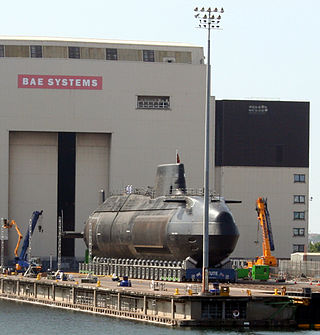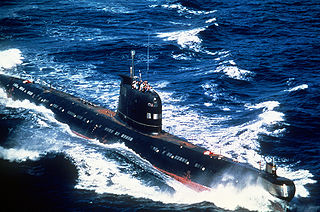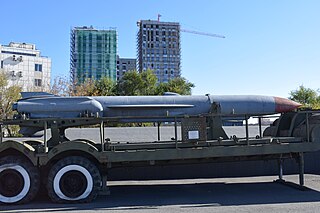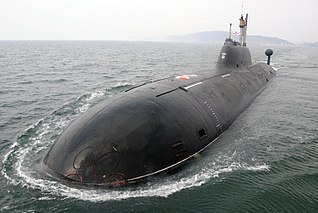
A nuclear submarine is a submarine powered by a nuclear reactor, but not necessarily nuclear-armed. Nuclear submarines have considerable performance advantages over "conventional" submarines. Nuclear propulsion, being completely independent of air, frees the submarine from the need to surface frequently, as is necessary for conventional submarines. The large amount of power generated by a nuclear reactor allows nuclear submarines to operate at high speed for long periods, and the long interval between refuelings grants a range virtually unlimited, making the only limits on voyage times being imposed by such factors as the need to restock food or other consumables.

The Indian Navy is the maritime branch of the Indian Armed Forces. The President of India is the Supreme Commander of the Indian Navy. The Chief of Naval Staff, a four-star admiral, commands the navy. As a blue-water navy, it operates significantly in the Persian Gulf Region, the Horn of Africa, the Strait of Malacca, and routinely conducts anti-piracy operations and partners with other navies in the region. It also conducts routine two to three month-long deployments in the South and East China seas as well as in the western Mediterranean sea simultaneously.

The Akula class, Soviet designation Project 971 Shchuka-B is a series of fourth generation nuclear-powered attack submarines (SSNs) first deployed by the Soviet Navy in 1986. There are four sub-classes or flights of Shchuka-B, consisting of the original seven Project 971 boats, commissioned between 1984 and 1990; six Project 971Is, commissioned between 1991 and 2009; one Project 971U, commissioned in 1995; and one Project 971M, commissioned in 2001. The Russians call all of the submarines Shchuka-B, regardless of modifications.

The Foxtrot class was the NATO reporting name of a class of diesel-electric patrol submarines that were built in the Soviet Union. The Soviet designation of this class was Project 641. The Foxtrot class was designed to replace the earlier Zulu class, which suffered from structural weaknesses and harmonic vibration problems that limited its operational depth and submerged speed. The first Foxtrot keel was laid down in 1957 and commissioned in 1958 and the last was completed in 1983. A total of 58 were built for the Soviet Navy at the Sudomekh division of the Admiralty Shipyard, Saint Petersburg. Additional hulls were built for other countries.

An SSN is a nuclear-powered general-purpose attack submarine. SSN is the US Navy hull classification symbol for such vessels; the SS denotes a submarine and the N denotes nuclear power. The designation SSN is used for interoperability throughout NATO under STANAG 1166, though navies use other terms.

INS Khukri was a Type 14 (Blackwood-class) frigate of the Indian Navy. She was sunk off the coast of Diu, Gujarat, India by the Pakistan Navy Daphné-class submarine Hangor on 9 December 1971 during the Indo-Pakistani War of 1971. This was the first warship sunk in action by a submarine since World War II. It remains the post-independence Indian navy's only warship to be lost in war.

Sindhughosh-class submarines are Kilo-class diesel-electric submarines in active service with the Indian Navy. Their names are in Sanskrit, but in their Roman-alphabet forms sometimes a final short -a is dropped.

The Arihant-class is a class of Indian nuclear-powered ballistic missile submarines being built for the Indian Navy. They were developed under the ₹900 billion (US$11 billion) Advanced Technology Vessel (ATV) project to design and build nuclear-powered submarines. These vessels are classified as 'strategic strike nuclear submarines' by India.

The P-70 Ametist was an anti-ship missile carried by Soviet and Indian Project 670 submarines, as well as the Soviet Project 661 Anchar. It was soon succeeded by the P-120 Malakhit (SS-N-9 'Siren').

The Project 670 Skat submarine was a nuclear-powered cruise missile submarine built for the Soviet Navy and later operated by the Russian Navy. All Charlie I/II-class submarines are decommissioned. One Charlie-class submarine was used for testing an Oniks missile. Charlie I and its successor Charlie II-class submarines are designed by the Lazurit Central Design Bureau of Gorky.

Nerpa is a 8,140-tonne (8,010-long-ton) Project 971 nuclear-powered attack submarine. The construction of the submarine was started in Russia in 1993, but was suspended due to lack of funding. India then sponsored further construction and sea trials of the submarine provided it was leased to the Indian Navy for 10 years. It was launched as K-152 Nerpa in October 2008 and entered service with the Russian Navy in late 2009. The submarine was leased to the Indian Navy in 2011 after extensive trials, and was formally commissioned into service as INS Chakra with the Eastern Naval Command at a ceremony in Visakhapatnam on 4 April 2012. In June 2021 Chakra was spotted on the surface escorted by Indian and Russian warships in the Singapore Strait while presumably heading towards the Russian naval base in Vladivostok; some media speculated that she was returning to Russia before the expiry of the lease term.
Two Russian submarines have been named Nerpa:

The K-152 Nerpa accident occurred aboard the Russian submarine K-152 Nerpa on 8 November 2008, which resulted in the deaths of 20 people and injuries to 41 more. The accident was blamed on a crew member who was allegedly playing with a fire suppressant system that he thought was not operative.

INS Arihant, designated S2 Strategic Strike Nuclear Submarine, is the lead ship of India's Arihant class of nuclear-powered ballistic missile submarines. The 6,000 tonne vessel was built under the Advanced Technology Vessel (ATV) project at the Ship Building Centre in the port city of Visakhapatnam.
One ship and three submarines of the Polish Navy have been named ORP Sokół :

K-43 was a Charlie-class nuclear-powered cruise missile submarine operated by the Soviet and Indian navies. It was built between 1964 and 1967 and was commissioned into the Soviet navy on 5 November 1967. It later served as INS Chakra in the Indian Navy from 1988 to 1991.
The Indian Navy aims to procure new nuclear-powered attack submarines under Project 75 Alpha. The Government of India approved the construction of six of such submarines in February 2015. These will be designed by the Navy's in-house Directorate of Naval Design and built in India at the Shipbuilding Centre at Visakhapatnam. The construction is expected to commence on 2023-24 while the first submarine is expected to enter service in 2032.
This page is based on this
Wikipedia article Text is available under the
CC BY-SA 4.0 license; additional terms may apply.
Images, videos and audio are available under their respective licenses.











